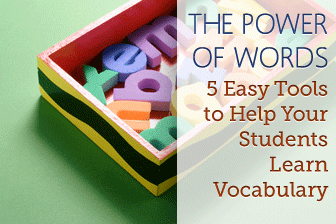Vocabulary instruction is a part of every ESL class. Whether you are teaching reading, speaking or listening, your students will encounter unfamiliar words.
As an ESL teacher, part of your job is helping your students learn these words and increase their functional vocabularies, but that vocabulary learning does not have to be boring. Here are some easy and fun tools you can use to help your students increase their lexical understanding.

Try These 5 Easy Tools to Help Your Students Learn Vocabulary
-
1
Hold a Word Sale
Increase your students’ vocabulary and decorate your classroom at the same time by challenging students to make an advertisement for a specific word. Using a set of vocabulary related to a current unit, assign one word to each of your students and ask them to create a poster sized advertisement for that word. In their ad, they should illustrate the meaning of the word and include the word itself. Then, post these ads around your classroom while you are studying the unit. Each student will not only learn the word that he was assigned. By looking at the advertisements created by his classmates, he will also learn the rest of the vocabulary set.
-
2
Use a Rebus
A rebus is a short story (usually no more than 100 words) which uses pictures in place of certain vocabulary words throughout the story. Your students can turn a plain text into a rebus with a few illustrated copies of key words in the story. Start with a story or text your students will enjoy, and then identify around a dozen concrete words in the text that can be illustrated. Then, using clip art, images available online, or your own artistic skills, make copies of those pictures. If you can, keep all the pictures around one inch by one inch, have your students cut them out, and then give them the text. As they read, they can place the pictures over the corresponding vocabulary words in the text. If you want to use the rebus again or rotate a set of rebuses through your students, have each person put her story and its corresponding pictures into an envelope. You can then make these available during independent reading time, and your students will love the vocabulary activity that feels more like a game!
-
3
Use the Margins
If your students own their textbooks or you make copies of what you read as a class, encourage your students to write in the margins. This simple tool of drawing pictures or taking notes in the margin will help students remember vocabulary that can be found in the text. Ask students to circle a given vocabulary word and draw a line to the margin of the paper. Now, each person should illustrate or define that particular word. This technique of writing notes in the margin is classified as “marginalia” and will help students who need visual clues for effective learning.
-
4
Flashcards
You already know what an asset BusyTeacher.org is to your class preparation. Now may be the perfect time to embrace a different resource set our site has to offer. Busy Teacher has hundreds of flashcards that you can print for free, and there are many ways to use these flashcards in your classroom! The simple, classic method is to make the flashcards available to your students for independent study time, but you do not have to stop there. Use the cards for a memory style game, use two duplicate sets to play go fish, or let your students come up with their own games for using flashcards in the classroom. The cards make small, digestible bites of language that your students can take in at their own paces. You can store sets of flashcards in a small box in a corner of your classroom or encourage each of your students to keep their own collection. If you like, laminate the cards to give them a longer lifespan.
-
5
Keep a Dictionary
It may be an oldie, but it is still a goodie – keeping a personal dictionary. With a simple notebook, your students can create their own dictionaries of new vocabulary words. Using a logical organizational scheme – alphabetical, by theme, etc. – students should write down any new words they encounter. Then, have students either illustrate the word or write their own definition in English for the word. Doing so will cement the word in their useful vocabulary. As they write each word, they see it in their own handwriting, which provides visual clues. By writing an English definition, your students will make connections between the new word and the words they already know in English. Moreover, every time your students add a new word to a page they see the others they are in the process of learning, and looking up new words puts a physical link to the word, which is helpful to kinesthetic learners.
These are just a few simple tools you can use in any ESL class to help your students learn and solidify an ever increasing collection of vocabulary.
Making the most of these tools will help your students make the most of their language learning process, and they will be well on their ways to fluency.
What are some of your most useful vocabulary learning tools? Share them with us in the comments below!
P.S. If you enjoyed this article, please help spread it by clicking one of those sharing buttons below. And if you are interested in more, you should follow our Facebook page where we share more about creative, non-boring ways to teach English.







